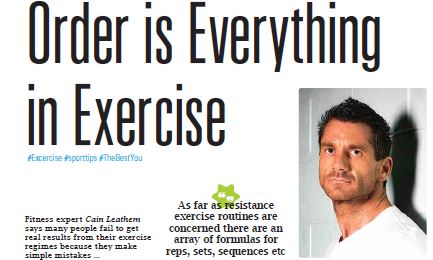Fitness expert Cain Leathem says many people fail to get real results from their exercise regimes because they make simple mistakes.
An effective exercise regime should achieve results (sounds pretty obvious!) but so many don’t. one principle that will make the difference is exercise order. For example, many people start their programs with cardio-vascular (aerobic) work and move on to resistance (weights) work afterwards. This is not taking advantage of the body’s natural order of utilising energy substrates. a simple, yet amazingly effective rule is simply to reverse this order.
After doing 5-10 minutes warm-up carry out your weight-training program (to improve strength, posture, stability, lean muscle tone etc). This requires sugars for energy (in the form of blood sugar and stored glycogen from muscle and liver stores).
Then move on to your cardiovascular work. Since your sugar stores have been depleted, your body is forced to utilise more fat-stores as an energy source – resulting in more fat loss. Sounds pretty good, huh?
The stimulation of muscle from the resistance work will increase your resting metabolism, providing you have adequate rest and nutrients (e.g. protein). So this program will result in an increased metabolism, increased fat breakdown as well as better posture, tone, strength and so much more… And don’t forget your stretches!! As far as resistance exercise routines are concerned there is an array of formulas for reps, sets, sequences etc. I am not going to prescribe any set routines as I feel this should only be done after assessing each individual.
What I will say is that a few simple guidelines will help you on your way: Beginners may do well on a whole body routine to start. only 1-2 exercises should be carried out per body part.
This is to practise correct exercise technique (preferably post professional instruction). I would suggest starting with larger muscle groups, such as the chest, legs and back and descending in size and complexity of movement. The heavier compound exercises are more taxing on the central nervous system and stabiliser muscles (co-ordination, posture etc.).
I also work opposing muscle groups sequence. For instance putting chest and back together, hamstrings and quadriceps, biceps and triceps etc. This is to ensure that you do not cause imbalances in muscles, which can negatively affect movement and posture. I would maybe suggest that you complete the exercises for the chest and back followed by the legs and then return to shoulders and arms. This gives an upper-lower-upper body sequence to instil some rest periods for those areas during the workout.
Always finish your workout with abdominals as starting with them will weaken your support structure and can easily lead to lower back injuries, especially if undertaking overhead work or heavy work such as squats. To strengthen your stabiliser and core section you should consider some exercises specifi c to these areas such as Swiss-ball work.
This is not a blueprint for all workouts and as you progress you should move into split routines etc, to intensify your workouts without over-training.
Never let your weights session last longer than one hour and ensure adequate rest between workouts! So why do so many people get it wrong? – I don’t know! all I know is that my clients get it right – and look great for it! If you want expert advice see an expert…




